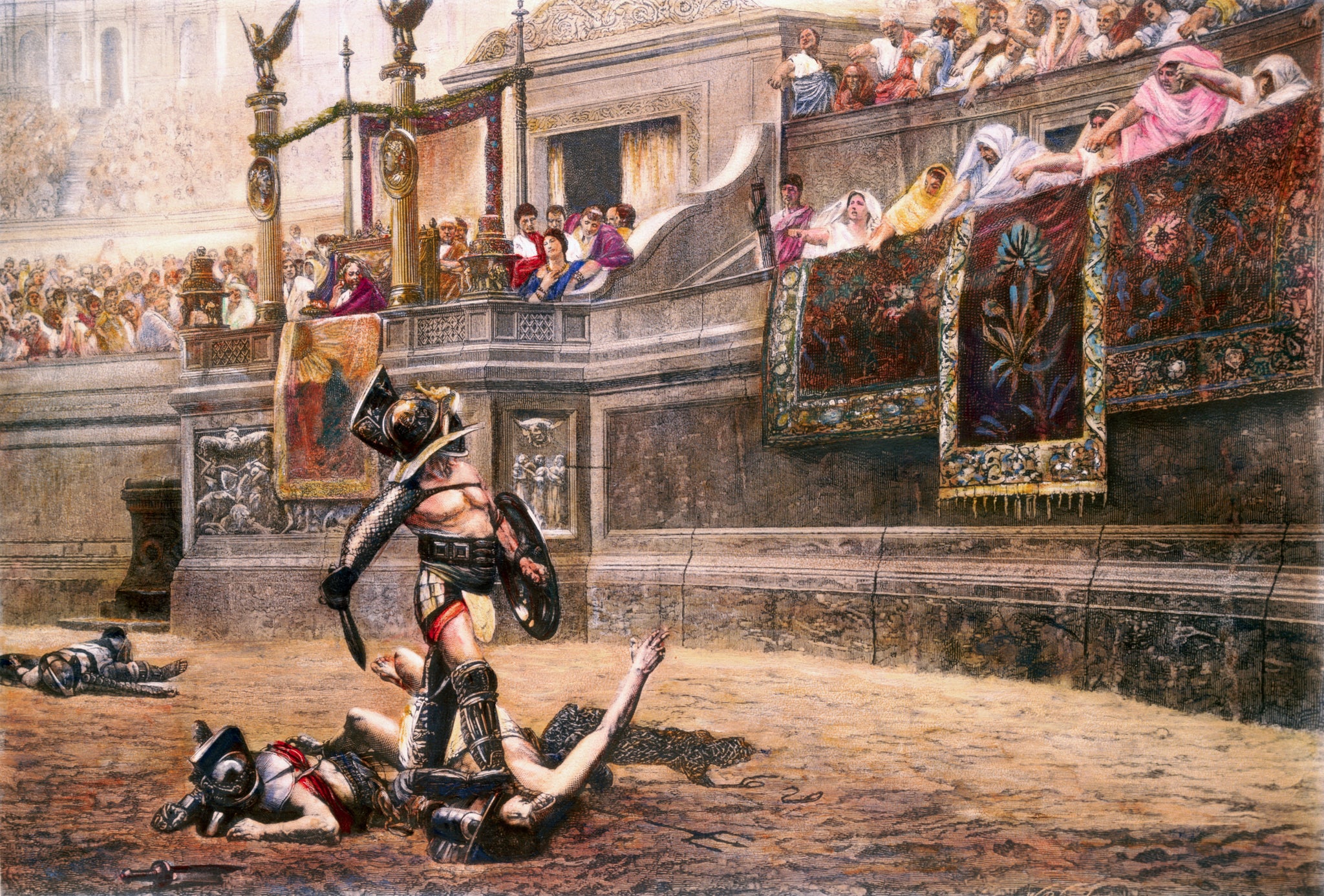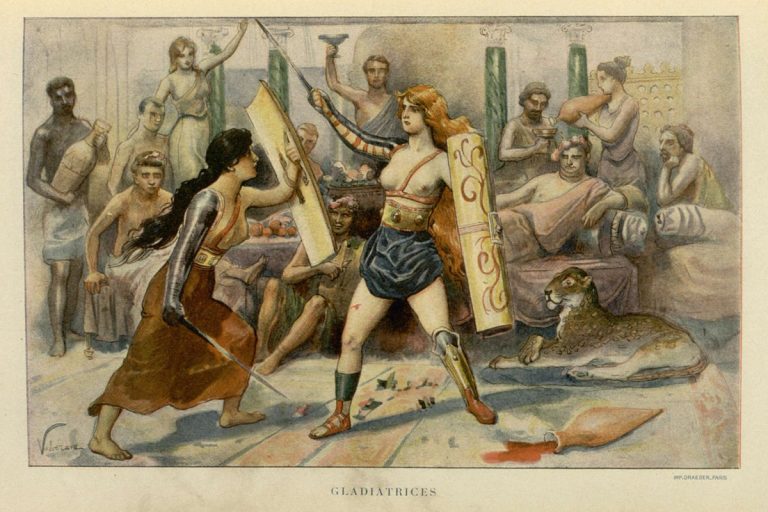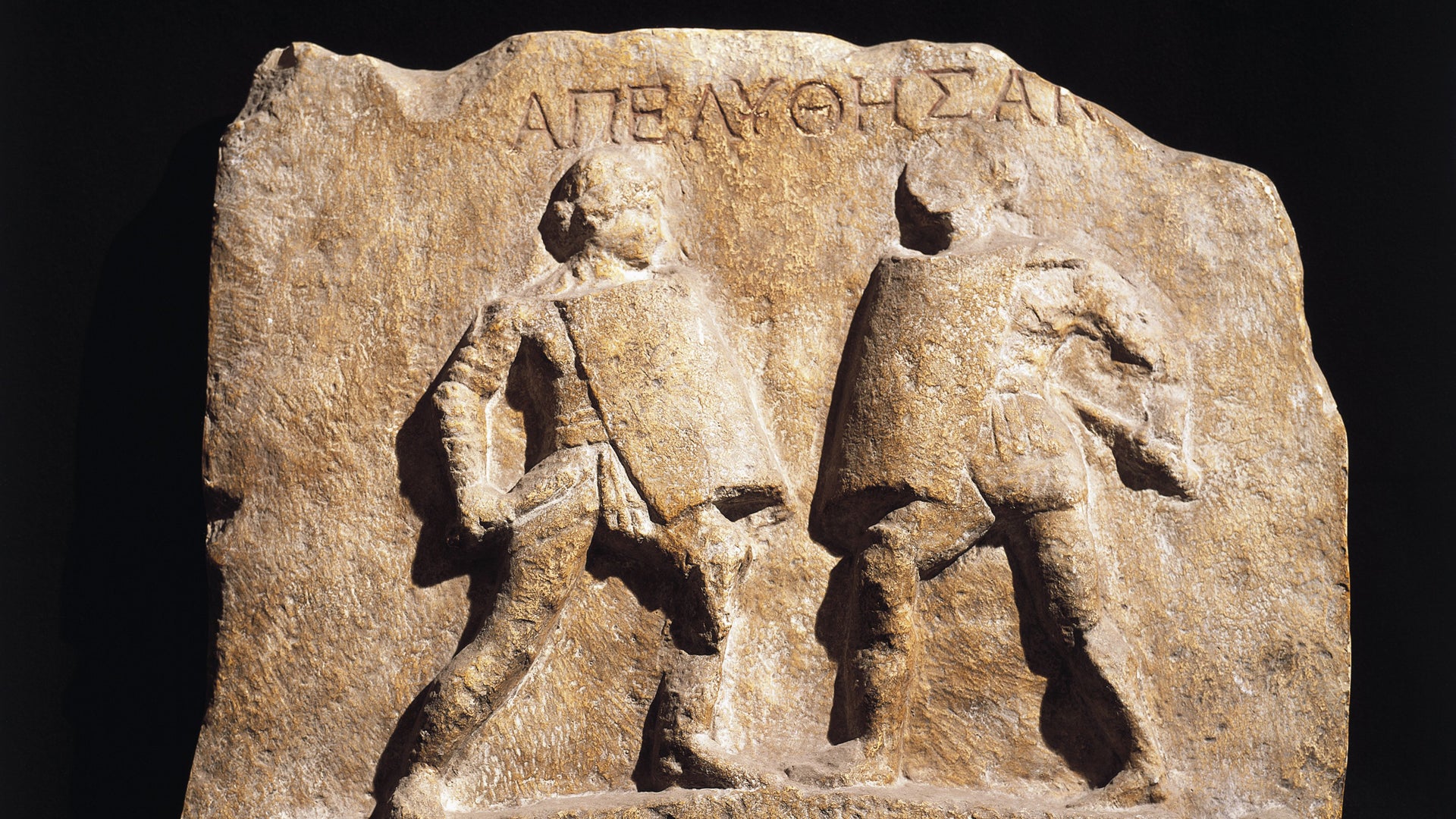Were there female gladiators in ancient Rome? While sparse, evidence exists in art, laws and written accounts that women did participate in the brutal sport during the late Roman Republic and early Roman Empire, fighting each other fiercely with weapons for entertainment. But they didn’t fight nearly to the same degree as men did—and did so mostly as novelty acts.

Written history has numerous accounts of female gladiators. Historians at the time described women sparring with each other as after-dinner acts in the first century B.C. and battling beasts, dwarfs and other women in spectacles hosted by emperors Nero, Titus and Domitian. Female gladiators fought in the thriving city of Pompeii. And an inscription found in the port city of Ostia shows a local magistrate boasting of being the first to “provide women for the sword” since the city’s founding.
WATCH: Full episodes of Colosseum online now.
Some Women Gladiators Came From the Elite
Women of all classes participated. Enslaved women generally worked for wealthy families, and an entrepreneurial owner might sense an opportunity, says David S. Potter, a professor of classics at the University of Michigan who has written extensively about ancient sports. “He’d say, ‘You’re strong. Let’s get you trained as a gladiator. You’ll make a lot of money from your fights.'”
Middle and upper-class women also fought—for the same reasons that young men of privilege did, says Potter: “It’s exciting. It’s different. It pisses off their parents.”
At the time, women engaged in a variety of sports and prized staying in shape, Potter says. Roman officials encouraged them, to build strength for childbirth. Affluent women could afford training and had the leisure time to work out. Professional gladiator troupe managers encouraged those who excelled at wrestling to try gladiatorial combat, which offered money and glamour. “If we think about this as a form of entertainment, it’s clearer why women would want to do it,” says Potter.
The Roman Senate passed laws in 11 and 19 A.D. prohibiting middle and upper-class women from fighting as gladiators—apparently to little effect since accounts of high-born women doing so continued for two centuries afterward.
Depictions of Women Gladiators in Art

Only one surviving work of art, housed in the British Museum, clearly depicts female gladiators: An ancient marble relief found in Halicarnassus, in what is now Turkey, shows two women battling with shields, swords and leg protectors. The figures are labeled Amazon and Achillia, likely stage names to evoke Greek mythology. An inscription over their heads indicates they fought to an honorable draw.
Other works representing female gladiators may have been misinterpreted for centuries, scholars say. A bronze sculpture from the first century A.D., kept at the Museum für Kunst und Gewerbein in Germany, was long thought to be a woman holding a cleaning tool. A 2011 re-evaluation by a Spanish scholar suggests she was more likely a female gladiator raising a short, curved sword, called a sica, aloft in triumph. She is also bare-chested, as gladiators typically fought.
One of the most intriguing discoveries came in 1996 when archaeologists from the Museum of London unearthed a fragment of a woman’s pelvis among the cremated ashes in an elaborate Roman-era grave in the London borough of Southwark. Decorative items and the remains of a lavish feast suggested it was the burial site of a gladiator. Jenny Hall, the Museum of London’s curator of early history at the time, said it was “70 percent probable” the deceased was a female gladiator, although some skeptics said the Great Dover Street Woman, as she was dubbed, could have been a gladiator’s wife or girlfriend or a fan instead.
The Gladiator Tradition

There is much more surviving evidence of male gladiators, who fought for nearly a thousand years all over the Roman Empire, which at its peak stretched from western Asia to the British Isles. In Rome itself, gladiator bouts began as part of lavish funeral services in the first centuries B.C., particularly among politically ambitious aristocrats. In 65 B.C., Julius Caesar used 320 pairs of gladiators ostensibly to honor his long-dead father. Although the contests were bloody, gladiators were seen as paragons of strength and valor who could inspire crowds to greater loyalty to Rome.
Many male gladiators were enslaved persons or prisoners of war, but young freemen could also volunteer to risk their lives in hopes of fame and fortune. Popular gladiators were revered as sex symbols and feted at the equivalent of fan bars in Rome. Training schools proliferated; event sponsors would rent whole troupes of gladiators from professional managers. Combatants often shared the fees. Slaves could hope to buy their freedom after winning several successful bouts.
Contrary to Hollywood portrayals, gladiators seldom fought to the death. A defeated gladiator would raise one finger, leaving the sponsor to decide his fate, often with input from the crowd. But having a gladiator slain required the sponsor to pay the troupe manager a hefty fee—10 times the rental cost, says Potter. He estimates the odds of a gladiator dying in any contest at about 1 in 20.
Read more stories about the history of Ancient Rome.
The Novelty of Women Gladiators
Audiences did crave novelty, however, which spurred sponsors to offer ever-more exotic acts. Female gladiators battling each other fit that bill. According to Roman historian Cassius Dio, Nero held an exhibition in 59 A.D. “that was at once most disgraceful and most shocking, when men and women not only of the [middle class] but even of the senatorial order…drove horses, killed wild beasts and fought as gladiators, some willingly and some sore against their will.” In 66 A.D., Nero had female gladiators battle at games honoring his mother, whom he had murdered.
Emperor Domitian held gladiator bouts at nighttime by torchlight, sometimes pitting women against dwarfs as well as each other, according to Cassius Dio and Suetonius, another Roman historian.
READ MORE: 11 Roman Emperors Who Helped Mold the Ancient World
What Roman Society Thought
Roman society still took a dim view of married women competing in the arena. The Roman poet Juvenal mocked men who allowed their wives to fight, writing, “What a great honor it is for a husband to see, at an auction, where his wife’s effects are up for sale, belts, shin-guards, arm-protectors and plumes!… Hear her grunt and groan as she works at it, parrying and thrusting. See her neck bent down under the weight of her helmet.”
In 200 A.D., the emperor Septimius Severus banned all female gladiatorial combat, reportedly after hearing such lewd jokes directed at women in an athletic contest that he feared the sport bred disrespect for all women.
The fervor for gladiators, in general, had greatly diminished by the fifth century—partly due to the spread of Christianity, which found it distasteful, and partly because the costs to stage such events grew untenable as the western Roman Empire collapsed.





